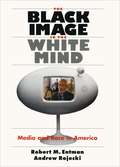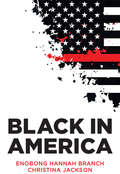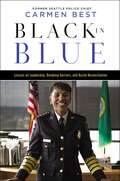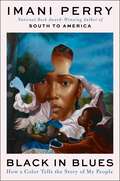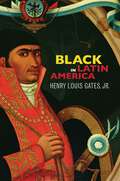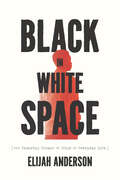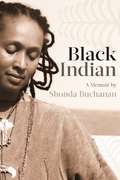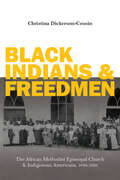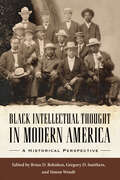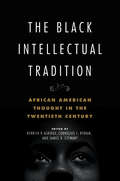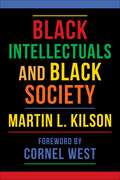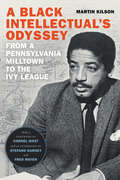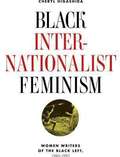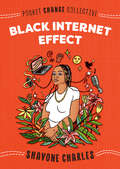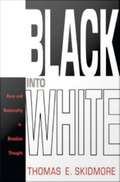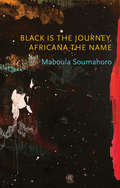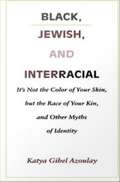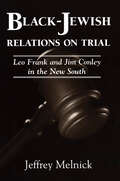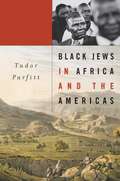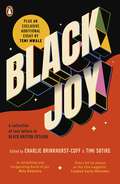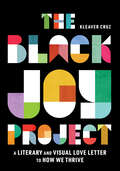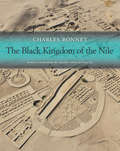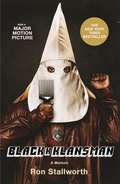- Table View
- List View
The Black Image in the White Mind: Media and Race in America (Studies In Communication, Media, And Pub Ser.)
by Robert M. Entman Andrew RojeckiLiving in a segregated society, white Americans learn about African Americans not through personal relationships but through the images the media show them. The Black Image in the White Mind offers the most comprehensive look at the intricate racial patterns in the mass media and how they shape the ambivalent attitudes of Whites toward Blacks. Using the media, and especially television, as barometers of race relations, Robert Entman and Andrew Rojecki explore but then go beyond the treatment of African Americans on network and local news to incisively uncover the messages sent about race by the entertainment industry-from prime-time dramas and sitcoms to commercials and Hollywood movies. While the authors find very little in the media that intentionally promotes racism, they find even less that advances racial harmony. They reveal instead a subtle pattern of images that, while making room for Blacks, implies a racial hierarchy with Whites on top and promotes a sense of difference and conflict. Commercials, for example, feature plenty of Black characters. But unlike Whites, they rarely speak to or touch one another. In prime time, the few Blacks who escape sitcom buffoonery rarely enjoy informal, friendly contact with White colleagues—perhaps reinforcing social distance in real life. Entman and Rojecki interweave such astute observations with candid interviews of White Americans that make clear how these images of racial difference insinuate themselves into Whites' thinking. Despite its disturbing readings of television and film, the book's cogent analyses and proposed policy guidelines offer hope that America's powerful mediated racial separation can be successfully bridged. "Entman and Rojecki look at how television news focuses on black poverty and crime out of proportion to the material reality of black lives, how black 'experts' are only interviewed for 'black-themed' issues and how 'black politics' are distorted in the news, and conclude that, while there are more images of African-Americans on television now than there were years ago, these images often don't reflect a commitment to 'racial comity' or community-building between the races. Thoroughly researched and convincingly argued."—Publishers Weekly "Drawing on their own research and that of a wide array of other scholars, Entman and Rojecki present a great deal of provocative data showing a general tendency to devalue blacks or force them into stock categories."—Ben Yagoda, New Leader Winner of the Frank Luther Mott Award for best book in Mass Communication and the Robert E. Lane Award for best book in political psychology.
Black in America: The Paradox of the Color Line
by Enobong Hannah Branch Christina JacksonAt the start of the twentieth century, the pre-eminent black sociologist, W.E.B. DuBois, identified the color line as America's great problem. While the color line is increasingly variegated beyond black and white, and more openly discussed than ever before as more racial and ethnic groups call America home, his words still ring true. Today, post-racial and colorblind ideals dominate the American narrative, obscuring the reality of racism and discrimination, hiding if only temporarily the inconvenience of deep racial disparity. This is the quintessential American paradox: our embrace of the ideals of meritocracy despite the systemic racial advantages and disadvantages accrued across generations. This book provides a sociology of the Black American experience. To be Black in America is to exist amongst myriad contradictions: racial progress and regression, abject poverty amidst profound wealth, discriminatory policing yet equal protection under the law. This book explores these contradictions in the context of residential segregation, labor market experiences, and the criminal justice system, among other topics, highlighting the historical processes and contemporary social arrangements that simultaneously reinforce race and racism, necessitating resistance in post-civil rights America.
Black in Blue: Lessons on Leadership, Breaking Barriers, and Racial Reconciliation
by Carmen BestWhatever your position is on Black Lives Matter, defunding the police, and equity in law enforcement, former police chief Carmen Best shares the leadership lessons she learned as the first Black woman to lead the Seattle Police Department—a personal insider story that will challenge your assumptions on how to move the country forward. Chief Carmen Best has spent the last 28 years as a member of a big-city police force, an institution where minorities and women have historically found it especially difficult to succeed. She defied the odds and became the first Black woman to lead the Seattle Police Department. During her tenure, she was successful in bringing significantly more diversity to the force. However, when the city council cut her budget amid months of protests against police violence, she had no choice but to step aside. Without the city&’s support, she felt she wouldn&’t be able to continue changing the status quo of the police force from within.Throughout her career, Chief Best has learned lessons that those coming up behind her can benefit from. In this book, she will use her story to share those urgent lessons. Readers will read about:How Chief Best grew up to believe in the change she set out to create.Her early days in the police force, including lessons from the academy and her time on patrol.How she progressed in her career within a primarily white law enforcement culture and the events that led to her becoming Chief.How she built her team and overcame the politics involved in her high-level position until the call for defunding came.Carmen Best teaches readers the core qualities and mindset to persevere and rise through the ranks, even within a workplace whose culture and leadership must be challenged, and policies changed on the way to achieving that vision. Her motivating story serves as a master class in guiding principles for anyone striving to serve their community and rise to the highest echelon of success.
Black in Blues: How a Color Tells the Story of My People
by Imani PerryNAMED A MOST ANTICIPATED BOOK BY: Time, USA Today, People, AARP, Harper's Bazaar, Today.com, BookRiot, Bustle, LitHub, BookPage, The Millions, Ms., Our Culture, Electric Literature, W, and VultureA surprising and beautiful meditation on the color blue—and its fascinating role in Black history and culture—from National Book Award winner Imani PerryThroughout history, the concept of Blackness has been remarkably intertwined with another color: blue. In daily life, it is evoked in countless ways. Blue skies and blue water offer hope for that which lies beyond the current conditions. But blue is also the color of deep melancholy and heartache, echoing Louis Armstrong’s question, “What did I do to be so Black and blue?” In this book, celebrated author Imani Perry uses the world’s favorite color as a springboard for a riveting emotional, cultural, and spiritual journey—an examination of race and Blackness that transcends politics or ideology.Perry traces both blue and Blackness from their earliest roots to their many embodiments of contemporary culture, drawing deeply from her own life as well as art and history: The dyed indigo cloths of West Africa that were traded for human life in the 16th century. The mixture of awe and aversion in the old-fashioned characterization of dark-skinned people as “Blue Black.” The fundamentally American art form of blues music, sitting at the crossroads of pain and pleasure. The blue flowers Perry plants to honor a loved one gone too soon.Poignant, spellbinding, and utterly original, Black in Blues is a brilliant new work that could only have come from the mind of one of our greatest writers and thinkers. Attuned to the harrowing and the sublime aspects of the human experience, it is every bit as vivid, rich, and striking as blue itself.
Black in Latin America
by Henry Louis Gates Jr.The third installment of Gates&’s documentary trilogy on the Black Experience, following America Behind the Color Line and Wonders of the African World. Selected as a 2012 Outstanding Title by AAUP University Press Books for Public and Secondary School Libraries 12.5 million Africans were shipped to the New World during the Middle Passage. While just over 11.0 million survived the arduous journey, only about 450,000 of them arrived in the United States. The rest—over ten and a half million—were taken to the Caribbean and Latin America. This astonishing fact changes our entire picture of the history of slavery in the Western hemisphere, and of its lasting cultural impact. These millions of Africans created new and vibrant cultures, magnificently compelling syntheses of various African, English, French, Portuguese, and Spanish influences. Despite their great numbers, the cultural and social worlds that they created remain largely unknown to most Americans, except for certain popular, cross-over musical forms. So Henry Louis Gates, Jr. set out on a quest to discover how Latin Americans of African descent live now, and how the countries acknowledge—or deny—their African past; how the fact of race and African ancestry play themselves out in the multicultural worlds of the Caribbean and Latin America. Starting with the slave experience and extending to the present, Gates unveils the history of the African presence in six Latin American countries—Brazil, Cuba, the Dominican Republic, Haiti, Mexico, and Peru—through art, music, cuisine, dance, politics, and religion, but also the very palpable presence of anti-black racism that has sometimes sought to keep the black cultural presence from view.
Black in White Space: The Enduring Impact of Color in Everyday Life
by Elijah AndersonFrom the vital voice of Elijah Anderson, Black in White Space sheds fresh light on the dire persistence of racial discrimination in our country. A birder strolling in Central Park. A college student lounging on a university quad. Two men sitting in a coffee shop. Perfectly ordinary actions in ordinary settings—and yet, they sparked jarring and inflammatory responses that involved the police and attracted national media coverage. Why? In essence, Elijah Anderson would argue, because these were Black people existing in white spaces. In Black in White Space, Anderson brings his immense knowledge and ethnography to bear in this timely study of the racial barriers that are still firmly entrenched in our society at every class level. He focuses in on symbolic racism, a new form of racism in America caused by the stubbornly powerful stereotype of the ghetto embedded in the white imagination, which subconsciously connects all Black people with crime and poverty regardless of their social or economic position. White people typically avoid Black space, but Black people are required to navigate the “white space” as a condition of their existence. From Philadelphia street-corner conversations to Anderson’s own morning jogs through a Cape Cod vacation town, he probes a wealth of experiences to shed new light on how symbolic racism makes all Black people uniquely vulnerable to implicit bias in police stops and racial discrimination in our country. An unwavering truthteller in our national conversation on race, Anderson has shared intimate and sharp insights into Black life for decades. Vital and eye-opening, Black in White Space will be a must-read for anyone hoping to understand the lived realities of Black people and the structural underpinnings of racism in America.
Black in White Space: The Enduring Impact of Color in Everyday Life
by Elijah AndersonFrom the vital voice of Elijah Anderson, Black in White Space sheds fresh light on the dire persistence of racial discrimination in our country. A birder strolling in Central Park. A college student lounging on a university quad. Two men sitting in a coffee shop. Perfectly ordinary actions in ordinary settings—and yet, they sparked jarring and inflammatory responses that involved the police and attracted national media coverage. Why? In essence, Elijah Anderson would argue, because these were Black people existing in white spaces. In Black in White Space, Anderson brings his immense knowledge and ethnography to bear in this timely study of the racial barriers that are still firmly entrenched in our society at every class level. He focuses in on symbolic racism, a new form of racism in America caused by the stubbornly powerful stereotype of the ghetto embedded in the white imagination, which subconsciously connects all Black people with crime and poverty regardless of their social or economic position. White people typically avoid Black space, but Black people are required to navigate the “white space” as a condition of their existence. From Philadelphia street-corner conversations to Anderson’s own morning jogs through a Cape Cod vacation town, he probes a wealth of experiences to shed new light on how symbolic racism makes all Black people uniquely vulnerable to implicit bias in police stops and racial discrimination in our country. An unwavering truthteller in our national conversation on race, Anderson has shared intimate and sharp insights into Black life for decades. Vital and eye-opening, Black in White Space will be a must-read for anyone hoping to understand the lived realities of Black people and the structural underpinnings of racism in America.
Black Indian (Made in Michigan Writers Series)
by Shonda BuchananBlack Indian, searing and raw, is Amy Tan’s The Joy Luck Club and Alice Walker’s The Color Purple meets Leslie Marmon Silko’s Ceremony—only, this isn’t fiction. Beautifully rendered and rippling with family dysfunction, secrets, deaths, alcoholism, and old resentments, Shonda Buchanan’s memoir is an inspiring story that explores her family’s legacy of being African Americans with American Indian roots and how they dealt with not just society’s ostracization but the consequences of this dual inheritance. Buchanan was raised as a Black woman, who grew up hearing cherished stories of her multi-racial heritage, while simultaneously suffering from everything she (and the rest of her family) didn’t know. Tracing the arduous migration of Mixed Bloods, or Free People of Color, from the Southeast to the Midwest, Buchanan tells the story of her Michigan tribe—a comedic yet manically depressed family of fierce women, who were everything from caretakers and cornbread makers to poets and witches, and men who were either ignored, protected, imprisoned, or maimed—and how their lives collided over love, failure, fights, and prayer despite a stacked deck of challenges, including addiction and abuse. Ultimately, Buchanan’s nomadic people endured a collective identity crisis after years of constantly straddling two, then three, races. The physical, spiritual, and emotional displacement of American Indians who met and married Mixed or Black slaves and indentured servants at America’s early crossroads is where this powerful journey begins. Black Indian doesn’t have answers, nor does it aim to represent every American’s multi-ethnic experience. Instead, it digs as far down into this one family’s history as it can go—sometimes, with a bit of discomfort. But every family has its own truth, and Buchanan’s search for hers will resonate with anyone who has wondered "maybe there’s more than what I’m being told."
Black Indians and Freedmen: The African Methodist Episcopal Church and Indigenous Americans, 1816-1916
by Christina Dickerson-CousinOften seen as ethnically monolithic, the African Methodist Episcopal (AME) Church in fact successfully pursued evangelism among diverse communities of indigenous peoples and Black Indians. Christina Dickerson-Cousin tells the little-known story of the AME Church’s work in Indian Territory, where African Methodists engaged with people from the Five Civilized Tribes (Cherokees, Creeks, Choctaws, Chickasaws, and Seminoles) and Black Indians from various ethnic backgrounds. These converts proved receptive to the historically Black church due to its traditions of self-government and resistance to white hegemony, and its strong support of their interests. The ministers, guided by the vision of a racially and ethnically inclusive Methodist institution, believed their denomination the best option for the marginalized people. Dickerson-Cousin also argues that the religious opportunities opened up by the AME Church throughout the West provided another impetus for Black migration. Insightful and richly detailed, Black Indians and Freedmen illuminates how faith and empathy encouraged the unique interactions between two peoples.
Black Intellectual Thought in Modern America: A Historical Perspective (Margaret Walker Alexander Series in African American Studies)
by Brian D. Behnken, Gregory D. Smithers and Simon WendtContributions by Tunde Adeleke, Brian D. Behnken, Minkah Makalani, Benita Roth, Gregory D. Smithers, Simon Wendt, and Danielle L. WigginsBlack intellectualism has been misunderstood by the American public and by scholars for generations. Historically maligned by their peers and by the lay public as inauthentic or illegitimate, black intellectuals have found their work misused, ignored, or discarded. Black intellectuals have also been reductively placed into one or two main categories: they are usually deemed liberal or, less frequently, as conservative. The contributors to this volume explore several prominent intellectuals, from left-leaning leaders such as W. E. B. Du Bois to conservative intellectuals like Thomas Sowell, from well-known black feminists such as Patricia Hill Collins to Marxists like Claudia Jones, to underscore the variety of black intellectual thought in the United States.Contributors also situate the development of the lines of black intellectual thought within the broader history from which these trends emerged. The result gathers essays that offer entry into a host of rich intellectual traditions.
The Black Intellectual Tradition: African American Thought in the Twentieth Century (New Black Studies Series #1)
by Derrick P. Alridge Keisha N. Blain Cornelius L. Bynum Jeffrey Lamar Coleman Pero Gaglo Dagbovie Stephanie Y. Evans Aaron David Gresson Claudrena N. Harold Leonard Harris Maurice J. Hobson La TaSha Levy Layli Maparyan Zebulon V. Miletsky R. Baxter Miller Edward Onaci Venetria K. Patton James B. Stewart Nikki M. TaylorConsidering the development and ongoing influence of Black thought From 1900 to the present, people of African descent living in the United States have drawn on homegrown and diasporic minds to create a Black intellectual tradition engaged with ideas on race, racial oppression, and the world. This volume presents essays on the diverse thought behind the fight for racial justice as developed by African American artists and intellectuals; performers and protest activists; institutions and organizations; and educators and religious leaders. By including both women’s and men’s perspectives from the U.S. and the Diaspora, the essays explore the full landscape of the Black intellectual tradition. Throughout, contributors engage with important ideas ranging from the consideration of gender within the tradition, to intellectual products generated outside the intelligentsia, to the ongoing relationship between thought and concrete effort in the quest for liberation. Expansive in scope and interdisciplinary in practice, The Black Intellectual Tradition delves into the ideas that animated a people’s striving for full participation in American life. Contributors: Derrick P. Alridge, Keisha N. Blain, Cornelius L. Bynum, Jeffrey Lamar Coleman, Pero Gaglo Dagbovie, Stephanie Y. Evans, Aaron David Gresson III, Claudrena N. Harold, Leonard Harris, Maurice J. Hobson, La TaSha B. Levy, Layli Maparyan, Zebulon V. Miletsky, R. Baxter Miller, Edward Onaci, Venetria K. Patton, James B. Stewart, and Nikki M. Taylor
Black Intellectuals: Race and Responsibility in American Life
by William M. Banks"In the volumes of literature on black history and thought too few books have focused on the black thinkers who have helped shape the course of American culture. Now, this landmark work reveals the complex and vital role of African American intellectuals in the United States." "It is a rich history, beginning with the arrival of Africans as slaves, when medicine men and conjurers held ancient, powerful wisdom. Author William Banks discusses with absorbing insight prominent figures ranging from such black pioneers as Alexander Crummell, Frederick Douglass, and Anna Cooper, to intellectuals of the modern age such as W. E. B. Du Bois, Alain Locke, E. Franklin Frazier, and Toni Morrison. These and hundreds of other black scholars and artists - many of them interviewed for this volume - people an enlightened and imaginative landscape, fascinating in both its range and its diversity." "Full in historical scope and cultural vision, Black Intellectuals also illuminates facets of American history such as African tribal traditions; American slavery; and black schools, churches, politics, and popular culture. It is a comprehensive and readable history of African American intellectuals."--BOOK JACKET. Title Summary field provided by Blackwell North America, Inc. All Rights Reserved
Black Intellectuals and Black Society
by Martin L. KilsonThis book presents the trailblazing political scientist Martin L. Kilson’s essays on leading Black intellectuals of the twentieth century. Kilson examines the ideas and careers of several key thinkers, placing their intellectual odysseys in the context of the dynamics that shaped the Black intelligentsia more broadly. He argues that the trajectory of twentieth-century Black intellectuals was determined by the interplay between formal ideas and Black egalitarian struggle.Beginning with the tension between W. E. B. Du Bois’s civil rights activism and Booker T. Washington’s accommodationism, Kilson explores the formation and evolution of Black intellectuals and activists across generations. Chapters consider Horace Mann Bond’s career in higher education, political scientist John Aubrey Davis’s transition from civil rights activist to federal policy technocrat, Ralph Bunche’s writings on European colonial rule in Africa, Harold Cruse’s classic polemic The Crisis of the Negro Intellectual, E. Franklin Frazier’s analysis of the Black bourgeoisie, Adelaide M. Cromwell’s studies of the challenges facing elite Black women, and Ishmael Reed and Cornel West’s advocacy as public intellectuals amid a conservative turn. Offering timely and engaging insights into the lives and work of pivotal Black intellectuals and activists, this book sheds new light on the abiding questions and debates in Black political thought.
A Black Intellectual's Odyssey: From a Pennsylvania Milltown to the Ivy League
by Martin KilsonIn 1969, Martin Kilson became the first tenured African American professor at Harvard University, where he taught African and African American politics for over thirty years. In A Black Intellectual's Odyssey, Kilson takes readers on a fascinating journey from his upbringing in the small Pennsylvania milltown of Ambler to his experiences attending Lincoln University—the country's oldest HBCU—to pursuing graduate study at Harvard before spending his entire career there as a faculty member. This is as much a story of his travels from the racist margins of twentieth-century America to one of the nation's most prestigious institutions as it is a portrait of the places that shaped him.He gives a sweeping sociological tour of Ambler as a multiethnic, working-class company town while sketching the social, economic, and racial elements that marked everyday life. From narrating the area's history of persistent racism and the racial politics in the integrated schools to describing the Black church's role in buttressing the town's small Black community, Kilson vividly renders his experience of northern small-town life during the 1930s and 1940s.At Lincoln University, Kilson's liberal political views coalesced as he became active in the local NAACP chapter. While at Lincoln and during his graduate work at Harvard, Kilson observed how class, political, and racial dynamics influenced his peers' political engagement, diverse career paths, and relationships with white people. As a young professor, Kilson made a point of assisting Harvard's African American students in adapting to life at a white institution.Throughout his career, Kilson engaged in pioneering scholarship while mentoring countless students. A Black Intellectual's Odyssey features contributions from three of his students: a foreword by Cornel West and an afterword by Stefano Harney and Fred Moten.
Black Internationalist Feminism: Women Writers of the Black Left, 1945-1995
by Cheryl HigashidaBlack Internationalist Feminism examines how African American women writers affiliated themselves with the post-World War II Black Communist Left and developed a distinct strand of feminism. This vital yet largely overlooked feminist tradition built upon and critically retheorized the postwar Left's "nationalist internationalism," which connected the liberation of Blacks in the United States to the liberation of Third World nations and the worldwide proletariat. Black internationalist feminism critiques racist, heteronormative, and masculinist articulations of nationalism while maintaining the importance of national liberation movements for achieving Black women's social, political, and economic rights. Cheryl Higashida shows how Claudia Jones, Lorraine Hansberry, Alice Childress, Rosa Guy, Audre Lorde, and Maya Angelou worked within and against established literary forms to demonstrate that nationalist internationalism was linked to struggles against heterosexism and patriarchy. Exploring a diverse range of plays, novels, essays, poetry, and reportage, Higashida illustrates how literature is a crucial lens for studying Black internationalist feminism because these authors were at the forefront of bringing the perspectives and problems of black women to light against their marginalization and silencing. In examining writing by Black Left women from 1945-1995, Black Internationalist Feminism contributes to recent efforts to rehistoricize the Old Left, Civil Rights, Black Power, and second-wave Black women's movements.
Black Internet Effect (Pocket Change Collective)
by Shavone Charles"This frank, spirited guide spotlights a thoughtful leader who embraces social responsibility." — KirkusWith witty humor and a strong sense of self, musician, model, and technology executive Shavone Charles recounts her journey through Google, Twitter, and more – and outlines her mission to make space for herself and other young women of color both online and IRL.Pocket Change Collective was born out of a need for space. Space to think. Space to connect. Space to be yourself. And this is your invitation to join us. This is a series of small books with big ideas from today's leading activists and artists. "The right balance of curiosity and good old nerve has always pushed me toward good directions in my life. During the darkest, most discouraging times, I can lean on those two parts of me." In this installment of the Pocket Change Collective, musician and technology phenom Shavone Charles explores how curiosity and nerve led her from a small college in Merced, California, to some of the most influential spaces in the tech world: from Google to Twitter to eventually landing a spot on the coveted Forbes 30 Under 30 list. Grateful for being the first in many spaces, but passionate about being neither the last nor the only, Charles tells her story in the hopes of guiding others and shaping a future where people, particularly women of color, feel empowered to make space for themselves and challenge society&’s status quos.
Black into White: Race and Nationality in Brazilian Thought
by Thomas E. SkidmorePublished to wide acclaim in 1974, Thomas E. Skidmore's intellectual history of Brazilian racial ideology has become a classic in the field. Available for the first time in paperback, this edition has been updated to include a new preface and bibliography that surveys recent scholarship in the field. Black into White is a broad-ranging study of what the leading Brazilian intellectuals thought and propounded about race relations between 1870 and 1930. In an effort to reconcile social realities with the doctrines of scientific racism, the Brazilian ideal of "whitening"--the theory that the Brazilian population was becoming whiter as race mixing continued--was used to justify the recruiting of European immigrants and to falsely claim that Brazil had harmoniously combined a multiracial society of Europeans, Africans, and indigenous peoples.
Black is the Journey, Africana the Name (Critical South)
by Maboula SoumahoroIn this highly original book, Maboula Soumahoro explores the cultural and political vastness of the Black Atlantic, where Africa, Europe, and the Americas were tied together by the brutal realities of the slave trade and colonialism. Each of these spaces has its own way of reading the Black body and the Black experience, and its own modes of visibility, invisibility, silence, and amplification of Black life. By weaving together her personal history with that of France and its abiding myth of color-blindness, Maboula Soumahoro highlights the banality and persistence of structural racism in France today, and shows that freedom will be found in the journey and movement between the sites of the Atlantic triangle. Africana is the name of that freedom. How can we build and reflect on a collective diasporic identity through a personal journey? What are the limits and possibilities of this endeavor, when the personal journey is that of oft-erased bodies and stories, de-humanized lives, and when Black populations in Africa, the Americas, and Europe identify and misidentify with each other, their sensibilities shaped by the particular locales in which their lives unfold? This book makes an important intellectual contribution to contemporary public conversations and theoretical inquiry into race, racism, blackness, and identity today, as it probes and questions the academic methodologies that have functioned as structures of exclusion.
Black, Jewish, and Interracial: It's Not the Color of Your Skin, but the Race of Your Kin & Other Myths of Identity
by Katya Gibel AzoulayHow do adult children of interracial parents--where one parent is Jewish and one is Black--think about personal identity? This question is at the heart of Katya Gibel Azoulay's Black, Jewish, and Interracial. Motivated by her own experience as the child of a Jewish mother and Jamaican father, Gibel Azoulay blends historical, theoretical, and personal perspectives to explore the possibilities and meanings that arise when Black and Jewish identities merge. As she asks what it means to be Black, Jewish, and interracial, Gibel Azoulay challenges deeply ingrained assumptions about identity and moves toward a consideration of complementary racial identities. Beginning with an examination of the concept of identity as it figures in philosophical and political thought, Gibel Azoulay moves on to consider and compare the politics and traditions of the Black and Jewish experience in America. Her inquiry draws together such diverse subjects as Plessy v. Ferguson, the Leo Frank case, "passing," intermarriage, civil rights, and anti-Semitism. The paradoxical presence of being both Black and Jewish, she argues, leads questions of identity, identity politics, and diversity in a new direction as it challenges distinct notions of whiteness and blackness. Rising above familiar notions of identity crisis and cultural confrontation, she offers new insights into the discourse of race and multiculturalism as she suggests that identity can be a more encompassing concept than is usually thought. Gibel Azoulay adds her own personal history and interviews with eight other Black and Jewish individuals to reveal various ways in which interracial identities are being lived, experienced, and understood in contemporary America.
Black-Jewish Relations on Trial: Leo Frank and Jim Conley in the New South
by Jeffrey MelnickAn analysis of the Leo Frank case as a measure of the complexities characterizing the relationship between African Americans and Jews in America In 1915 Leo Frank, a northern Jew, was lynched in Georgia. He had been convicted of the murder of Mary Phagan, a young white woman who worked in the Atlanta pencil factory managed by Frank. In a tumultuous trial in 1913 Frank's main accuser was Jim Conley, an African American employee in the factory. Was Frank guilty? In our time a martyr's aura falls over Frank as a victim of religious and regional bigotry. The unending controversy has inspired debates, movies, books, songs, and theatrical productions. Among the creative works focused on the case are a ballad by Fiddlin' John Carson, David Mamet's novel The Old Religion in 1997, and Alfred Uhry and Jason Robert Brown's musical Parade in 1998. Indeed, the Frank case has become a touchstone in the history of black-Jewish cultural relations. However, for too long the trial has been oversimplified as the moment when Jews recognized their vulnerability in America and began to make common cause with African Americans. This study has a different tale to tell. It casts off old political and cultural baggage in order to assess the cultural context of Frank's trial, and to examine the stress placed on the relationship of African Americans and Jews by it. The interpretation offered here is based on deep archival research, analyses of the court records, and study of various artistic creations inspired by the case. It suggests that the case should be understood as providing conclusive early evidence of the deep mutual distrust between African Americans and Jews, a distrust that has been skillfully and cynically manipulated by powerful white people. Black-Jewish Relations on Trial is concerned less with what actually happened in the National Pencil Company factory than with how Frank's trial, conviction, and lynching have been used as an occasion to explore black-Jewish relations and the New South. Just as with the O. J. Simpson trial, the Frank trial requires that Americans make a profound examination of their essential beliefs about race, sexuality, and power.
Black Jews in Africa and the Americas
by Tudor ParfittBlack Jews in Africa and the Americas tells the fascinating story of how the Ashanti, Tutsi, Igbo, Zulu, Beta Israel, Maasai, and many other African peoples came to think of themselves as descendants of the ancient tribes of Israel. Pursuing medieval and modern European race narratives over a millennium in which not only were Jews cast as black but black Africans were cast as Jews, Tudor Parfitt reveals a complex history of the interaction between religious and racial labels and their political uses. For centuries, colonialists, travelers, and missionaries, in an attempt to explain and understand the strange people they encountered on the colonial frontier, labeled an astonishing array of African tribes, languages, and cultures as Hebrew, Jewish, or Israelite. Africans themselves came to adopt these identities as their own, invoking their shared histories of oppression, imagined blood-lines, and common traditional practices as proof of a racial relationship to Jews. Beginning in the post-slavery era, contacts between black Jews in America and their counterparts in Africa created powerful and ever-growing networks of black Jews who struggled against racism and colonialism. A community whose claims are denied by many, black Jews have developed a strong sense of who they are as a unique people. In Parfitt’s telling, forces of prejudice and the desire for new racial, redemptive identities converge, illuminating Jewish and black history alike in novel and unexplored ways.
Black Joy
by VariousBlack joy is . . .The babble and buzz of the barber shop.Chicken and chips after school with your girls.Stepping foot in your mother country for the very first time.Feeling at one with nature.Learning to cook souse with your mum.Connecting with the only other Black colleague in your workplace.Loving and finding complete happiness in your fatness.Joy surrounds us. It can be found it in the day to day. It's what we live for. So why do we so rarely allow ourselves to revel in it? This must-read anthology is your invitation to do so - and is a true celebration of Black British culture in all its glory.Edited by award-winning journalist, and former gal-dem editor-in-chief, Charlie Brinkhurst-Cuff and up-and-coming talent Timi Sotire, twenty-eight iconic voices speak on what Black joy means to them in this uplifting and empowering anthology.With essays from:Munya Chawawa -- Leigh-Anne Pinnock -- Diane Abbott -- Jason Okundaye --Bukky Bakray -- Faridah Àbíké-Íyímídé -- Lavinya Stennett -- Henrie Kwushue Chanté Joseph -- Travis Alabanza -- Isaac James -- Sophia Tassew -- Lauryn Green -- Melz Owusu -- Timi Sotire -- Fope Olaleye -- Richie Brave -- Tope Olufemi -- Athian Akec -- Mikai Mcdermott -- Ife Grillo -- Rukiat Ashawe -- Mayowa Quadri -- Tobi Kyeremateng -- Haaniyah Angus -- Theophina Gabriel -- Ruby Fatimilehin -- Vanessa Kissule---"A refreshing and invigorating burst of joy, exploring the beauty in the nuances of our existence, honing in on what propels us forward, and establishing a vital hope" - BOLU BABALOLA, author of Love in Colour"Every bit as joyous as the title suggests'" CANDICE CARTY-WILLIAMS, author of Queenie"A rich, gorgeous celebration of the power in embracing joy" LIV LITTLE"Black Joy is a delightful celebration of Black Britishness" MASHABLE
The Black Joy Project
by Kleaver CruzThe perfect holiday gift for the book lover, art enthusiast and freedom fighter in your lifeFeaturing 117 full-color photos and eight breathtaking essays on a force that fuels Black life all around the globe, this is Humans of New York meets The Black Book"A patchwork quilt of visually stunning images, captured moments of triumph, antidotes to trauma narratives and rich, ebullient emotional and verbal spice for the soul." – Michael W. Twitty, culinary and cultural historian, and author of The Cooking Gene and Koshersoul"In literature, there are some books that transcend mere pages and ink, becoming essential pieces of cultural expression. One such book poised to make its mark is The Black Joy Project…. This ambitious work breaks new ground." – EssenceBlack Joy is everywhere. From the bustling streets of Lagos to hip-hop blasting through apartment windows in the Bronx. From the wide-open coastal desert of Namibia to the lush slopes of Jamaica’s Blue Mountains. From the thriving tradition of Candomblé in Bahia to the innovative and trendsetting styles of Soweto, and beyond, Black Joy is present in every place that Black people exist. Now—at last—is a one-of-a-kind celebration of this truth and a life-giving testament to one of the most essential forces that fuels Black life: The Black Joy Project.International in the scale, fist-raising in the prose, and chockfull of gorgeous works by dozens of acclaimed artists, The Black Joy Project does what no other book has ever done. In words and art, it puts joy on the same track as protest and resistance … because that is how life is actually lived. Uprisings in the street, with music as accompaniment. Heartbreaking funerals followed by second line parades. Microaggressions in the office, then coming home to a warm hug and a garden of lilacs. The list goes on.Black Joy is always held in tension with broader systemic wounds. It is a powerful, historically important salve that allows us to keep going and reimagine new ways of being. The Black Joy Project captures these dual realities to incredible, unforgettable effect.The brainchild of educator and activist Kleaver Cruz, The Black Joy Project is an extension of a real-world initiative of the same name. It has become a source of healing and regeneration for Black people of all backgrounds and identities. Long overdue and somehow still worth the wait, The Black Joy Project is a necessary addition for any book lover, art enthusiast, or freedom fighter. And begs the question, What does Black Joy mean to you?
The Black Kingdom of the Nile
by Charles BonnetFor centuries, Egyptian civilization has been at the origin of the story we tell about the West. But Charles Bonnet’s archaeological excavations have unearthed extraordinary sites in modern Sudan that challenge this notion and compel us to look to black Africa and the Nubian Kingdom of Kush, where a highly civilized state existed 2500–1500 BCE.
Black Klansman: Race, Hate, and the Undercover Investigation of a Lifetime
by Ron StallworthThe extraordinary true story and basis for the major motion picture BlacKkKlansman, written and directed by Spike Lee, produced by Jordan Peele, and starring John David Washington and Adam Driver. <P><P>When detective Ron Stallworth, the first black detective in the history of the Colorado Springs Police Department, comes across a classified ad in the local paper asking for all those interested in joining the Ku Klux Klan to contact a P.O. box, Detective Stallworth does his job and responds with interest, using his real name while posing as a white man. <P><P>He figures he’ll receive a few brochures in the mail, maybe even a magazine, and learn more about a growing terrorist threat in his community. A few weeks later the office phone rings, and the caller asks Ron a question he thought he’d never have to answer, “Would you like to join our cause?” <P><P>This is 1978, and the KKK is on the rise in the United States. Its Grand Wizard, David Duke, has made a name for himself, appearing on talk shows, and major magazine interviews preaching a “kinder” Klan that wants nothing more than to preserve a heritage, and to restore a nation to its former glory. <P><P>Ron answers the caller’s question that night with a yes, launching what is surely one of the most audacious, and incredible undercover investigations in history. Ron recruits his partner Chuck to play the "white" Ron Stallworth, while Stallworth himself conducts all subsequent phone conversations. <P><P>During the months-long investigation, Stallworth sabotages cross burnings, exposes white supremacists in the military, and even befriends David Duke himself. Black Klansman is an amazing true story that reads like a crime thriller, and a searing portrait of a divided America and the extraordinary heroes who dare to fight back. <P><b>A New York Times Bestseller</b>
